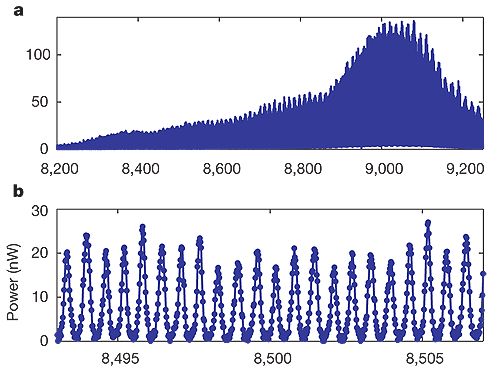An Astro-Comb for the WHT with a Precision of 1 cm·s-1
ING web news release
28th April, 2008
An 'astro-comb' is an optically filtered comb of evenly spaced frequency references, all derived from a single frequency source — a pulsed laser. Half a Noble Prize in Physics was awarded for the idea in 2005 and the first
application to astronomy came in 2007 (M. T. Murphy et al., 2007, MNRAS, 380, 839). Now a team from the Harvard-Smithsonian Center for Astrophysics in Cambridge, Massachusetts are the first to realize the concept in a way suitable for astronomical practice, in what could be a breakthrough in the precision of astronomical spectroscopy.
The accuracy and long-term stability of state-of-the-art astrophysical spectrographs are currently limited by the wavelength-calibration source, typically thorium-argon lamps or iodine absorption cells. In addition, existing calibration sources are limited in the red-to-near-IR spectral bands most useful for exoplanet searches around M stars.
Iodine cells have very few spectral lines in the red and near-IR spectral bands, while thorium-argon lamps have limited lines and unstable bright features that saturate spectrograph detectors.
Laser frequency combs have been suggested as potentially superior wavelength calibrators because of their good long-term stability and reproducibility, and because they have useful lines in
the red-to-near-IR range. By combining a laser frequency comb with a Fabry-Perot filtering cavity it is possible to achieve Doppler shift precisions of the order of 5 cm·s-1 and stability on at least a 1-year timescale,
necessary to find a 1-Earth-mass planet in an Earth-like orbit.
Recently Harvard scientists have fabricated such an astro-comb with up to 40-GHz (~1 Å) line spacing to be deployed at the HARPS-NEF (High-Accuracy Radial-velocity Planet Searcher of the
New Earths Facility) spectrograph in 2009 or 2010. HARPS-NEF provides a resolution of R=120,000 and it´s being built by the Harvard Origins of Life Initiative for the William Herschel telescope to
search for exoplanets.
 |
The astro-comb is tuned to span a bandwidth of ~1,000Å. The resolution
of Figure a is not high enough to show individual lines. For the TiO2/SiO2 multi-layer mirrors used in the FP cavity,
line stability ~1 cm·s-1 is expected on timescales of several years. Figure b shows a small
portion of the full output spectrum, showing individual filtered comb lines. Adapted by permission from Macmillan Publishers Ltd: Nature (Li et al., Nature, 452, 610), copyright 2008.
|
More information:
- E. Hand, 2008, "Easy ways to other Earths", Nature, 452, 514.
- C-H Li et al., 2008, "A laser frequency comb that enables radial velocity measurements with a precision of 1cms-1", Nature, 452, 610.
- "La Palma, punta de lanza en la búsqueda de planetas extrasolares terrestres", ABC newspaper, 3rd April 2008.
- A. Powell, "Laser precision added to search for new Earths: Measuring
ability leaps with new instrument", Harvard News.
- G. Walker, 2008, "With a coarse-tooth comb", Nature, 452, 538.
- "Combing the sky for 'earths'", Nature, 452, editor's summary.
- "Abstractions", Nature, 452, xiii.
|
|



